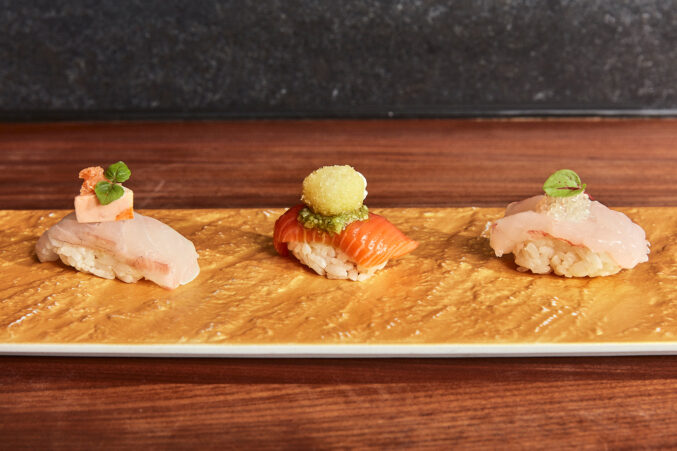 We have good news and bad news. The bad news is that bathing suit season is right around the corner. The good news is that you still have time to make your body bikini-ready. Sure, shedding that winter weight is not easy. That’s exactly why you need a personal trainer to guide you along the perilous path of health transformation.
We have good news and bad news. The bad news is that bathing suit season is right around the corner. The good news is that you still have time to make your body bikini-ready. Sure, shedding that winter weight is not easy. That’s exactly why you need a personal trainer to guide you along the perilous path of health transformation.
Fortunately, today’s personal trainers have integrated Western and Eastern philosophies to create challenging and fun workouts that address a variety of their clients’ health concerns. So you can forget about treadmills and bench presses. New fitness programs, such as Pilates and Gyrotonic, improve the body and help you find meaning, growth, and change in your life. Personal training is, well, personal.
So, we toast you—and your new bikini.
FIRST, A WELL-BALANCED BODY
Before you hire a personal trainer, you need to think about the meaning of fitness. It’s not sweating it out to get the “perfect body”; fitness improves your overall health. So training should include four elements: cardio-respiratory fitness (heart, lungs, and blood vessels); muscular strength (the ability to lift a heavy object) and endurance (the ability to use a muscle repeatedly); body composition (ratio of fat to lean muscle); and flexibility (range of motion in your joints).
Your trainer can test you in any of these elements. Based on the results, you can set goals and monitor your progress. By measuring your body fat before you begin training (no matter how humiliating that can be), you see tangible results, and fat fading away is a powerful incentive. Even so, expect to hold up your end of the training. “If you know the reason why you’re training—let’s say, to prevent heart disease—you’ll be more determined to stay committed to your ultimate goal,” says Ryan Tompkins, strength and conditioning coordinator for Baylor’s Tom Landry Fitness Center.
FREEMOTION, THE NEXT WAVE IN WEIGHTS
Traditional weights are undergoing a face-lift. Today’s sleek, high-tech, multiple-muscle machines (aka FreeMotion) strengthen your muscles like they’re used in real life—in unison—rather than tackling each muscle separately. Functional fitness strikes a balance between strengthening your “core” muscles (abs, back, hips, and pelvis) and strengthening your entire musculature. “If you’re going to train,” says Conrad Earnest, Ph.D., director of human performance research at the Cooper Institute, “why not go for the complete package—strengthening your core and training your balance? By practicing functional exercises in a controlled, safe environment under the guidance of your personal trainer, your body and brain can respond as trained in an uncontrolled setting.”
Better yet, you get the same benefits—a slowdown in bone loss and a boost in metabolism. Plus, you burn more calories and get swimsuit-worthy abs along with good-looking posture. Here’s how: multi-muscle machines don’t limit your movement as much as traditional weight machines. You pump reps while standing, kneeling, or sitting on an unstable surface such as a resist-a-ball, whereas traditional machines often use a bench or seat to support the body. A hamstring curl on a multi-muscle machine is performed in a standing position, which requires the stabilizing leg to use more muscles while the core keeps the body steady. In using a traditional hamstring machine, the body is supported by a bench. Just think—you can burn more calories as you work your body the way it moves in real life.
GYROTONIC, THE NEW TICKET TO FITNESS
Imagine a yoga class performed on a bench-press chair donning weight plates, leather straps, and pulleys. This innovative training technique goes beyond anything you’ve ever experienced—the moves are as strange as the machine. Nevertheless, this non-impact, total-body workout can be gentle or vigorous, depending on the weight used on the pulley tower, the apparatus invented by the father of Gyrotonic, Juliu Horvath. “Gyro opens up the joints and creates more space so the body glides better, which leaves my students feeling so stretched out,” says certified Gyrotonic and Pilates instructor Deborah Lueky of ParkGate Studio.
The goal is to expand the range of motion in your joints and increase the length and strength of your muscles. You’ll strengthen and stretch the spine in its natural movements and move your limbs in controlled circular patterns against the resistance of weighted plates. For instance, your teacher may guide you through an arch-and-curl series, moving the spine through extension, rotation, and flexion. After that, you may wrap the leather straps around your hands and move your arms in smooth arcs to complete an arm circle series. Similarly, the leather straps can fit around your feet, so you can do a leg circle series. Toward the end of 60 minutes, you’ll finish with some abdominal work. This full-body workout integrates breath work with each move. Yes, your mind and body will be challenged by the unusual exercises, but you’ll leave feeling as if you just got a massage.
PILATES, THE ULTIMATE AB TRAINER
You’ve probably heard of Pilates or-at least you’ve heard that’s how Jennifer Aniston maintains her fab figure. Maybe you’ve even taken a Pilates mat class. But there’s a whole other side to Pilates: leather straps, springs, trapezes, and equipment that looks more fitting for body manipulation than body workouts. The apparatuses (Reformer, Cadillac, Wunda Chair, and Ladder Barrel) grew out of a hands-on approach to healing developed by Joseph Pilates 77 years ago.
Just about every one of Pilates’ 500-plus exercises strengthen the “Power House,” a term he coined that means muscles of the core. A strong core supports your spine; strengthens the muscles of the hips, pelvis, and shoulders and allows those muscles to remain in their proper place as you move; reduces strain on the limbs; and keeps the injury-prone areas, such as your lower back, healthy. “Pilates strengthens the core to develop long, lean lines and a strong center of support,” says Alice Ann Dailey, one of the first instructors of Pilates in Dallas and owner of Oasis Mind and Body Conditioning. “The end results are narrow hips, flat stomach, and lost inches.”
Pilates has gained the respect of the rehabilitative community, including physical therapists, chiropractors, and orthopedic surgeons, because these exercises are bio-mechanically safe and certified instructors go through intensive training to learn proper body alignment and mechanics. “I teach body awareness, posture alignment, and how to use the belly correctly,” says Shelley Estes, a certified Pilates instructor and personal weight trainer at Goodbody’s. “Pilates can give clients a better quality of workout than other fitness activities because they’re more in touch with their bodies.”
YOGA, THE NEW FITNESS
EVEN IN TODAY’S UNINSPIRING economy, yoga studios are sprouting up on every corner. In any given yoga session, you’ll stretch, strengthen, breathe, and soothe a little stress. A typical Power Yoga class (the most popular in Dallas) combines cardio with isometric strengthening as you stretch and sweat through several series of poses. But, there’s a fine line between the world’s healthiest exercise and an aching body—today’s classes often look more like an audition for a Britney Spears video than the slow, controlled poses of traditional yoga. As studios pop up, so do instructors with various levels of training. Aspiring yogis are learning down dogs and headstands in as little as 15-hour weekend workshops, which can do as much harm to yoga as it does to you. If your knee or back hurts in a pose, an instructor should understand why and how to adjust the pose so the pain goes away. Herniated discs, ripped cartilage, inflammation in the knees, tendonitis, pinched nerves—muscles stretching beyond their natural length—can sever the precious “union” between body and mind or, worse, turn you off from yoga. Learn from someone who tells you to listen to your body, lets you work at your own level, teaches modifications, and corrects poses. For all you neophytes, private lessons can ease the learning curve so you can get the most out of your yoga—safely. Yoga hasn’t flourished for thousands of years only to cause harm to the body. It gets the body as healthy as it can be on its own time.
HOW TO CHOOSE A PERSONAL TRAINER
Picking a trainer is like picking a doctor: you want a professional, competent person who’s dedicated to his own health, as well as yours.
Ask about certifications. The personal trainer you choose should have an acceptable certification and a strong foundation in wellness. If you want to weight train, the American College of Sports Medicine (ACSM) or the National Strength and Conditioning Association (NSCA) are highly respected certifying bodies. For example, to personal weight train at Baylor’s Tom Landry Fitness Center, a personal trainer must have one of these certifications and a bachelor’s degree in a related sports field. Certifications are not the end-all, be-all, but they do reflect that a personal trainer is serious enough to learn and stay current in the field of fitness.
Ask about insurance. Personal trainers must have insurance, and make sure the gym itself is insured as well.
Ask about training style. You don’t want to be training for a triathlon when your goal is only to lose a few pounds. Today’s trainers are branching out in other forms of fitness, and they specialize in specific health needs. Make sure the trainer meets your specific needs. Besides solid credentials, trainers should be passionate about training you—friendly, upbeat, and empathetic toward your feelings and physical limitations. In choosing a yoga instructor, for example, find someone whom you trust and who has worked on her own life, physically and mentally. Personal trainers are your inspiration.
Check references. If they don’t put you in touch with any clients, then consider another trainer. Word of mouth is still the best way to find an instructor. Beware of trainers who talk in extremes—”always” and “never.” It’s emotionally and physically dangerous to view fitness as black and white. Fitness is evolving, as are you. What you did in your 20s may not work for you in your 40s.
WHERE TO WORK OUT
A few local sources for your new personal-training regime. Expect to pay about $50-$60 per session.
ALL-AROUND GOOD TRAINERS
Park Cities Personal Training
4514 Travis St., Ste. 115. 214-526-4224.
FREEMOTION WEIGHTS
Baylor-Tom Landry Fitness Center
411 N. Washington Ave. 214-820-7787.
Cooper Fitness Center
12100 Preston Rd. 972-233-4832.
Preston Center Personal Training
8411 Preston Rd., Ste. 216. 214-890-0888.
GYROTONIC STUDIOS
ParkGate Studio
2801 Wycliff Ave. @ Dallas North Tollway.
214-559-9818.
Freedom Fitness
5019 N. Central Expwy., Ste. A. 214-566-3318.
PILATES STUDIOS
Park Cities Pilates Center
6607 Hillcrest Ave., Ste. 200. 214-378-5228.
www.parkcitiespilates.com
Oasis Mind and Body Conditioning Center
11661 Preston Rd., Ste. 184. 214-692-6613.
Goodbody’s Wellness Center
5301 Lovers Ln., Ste. 114. 214-351-9931.
YOGA PRIVATES
Yoga Power
1908 Abrams Pkwy. 214-370-4410.
Power Yoga Privates
Paula Weithman
12835 Preston Rd., Ste. 427. 972-239-4202.
Iyengar Privates
Dallas Yoga Center
4525 Lemmon Ave., Ste. 305. 214-443-9642.
www.dallasyogacenter.com
Vinyasa Privates
Credits
Get our weekly recap
Related Articles

Bill Hutchinson Pleads Guilty to Misdemeanor Sex Crime

The Best Japanese Restaurants in Dallas



